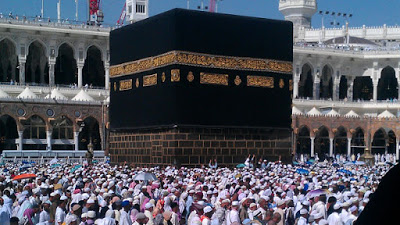Hajj is a very tough journey, full of rites that demand patience, struggle and sacrifice. In simple term, Hajj is a stressful exercise. No wonder the reward is Paradise! Despite the fact that technology has made many things easy for the holy travelers in terms of transportation, facilities and conveniences, the journey is becoming more stressful because of the yearly increasing pilgrims’ population, financial demand and spiritual degradation amongst followers of the Islamic faith. Unfortunately, some Muslims are taking Hajj as a tourist trip devoid of any spiritual value. It should not be so. Hajj is surely a divine journey to be performed by a capable Muslim only once in a life time. Therefore, Muslims must adhere to this divine call and ensue that they carry it out for the sake of Allah alone and in accordance with the teaching of our noble Prophet Muhammad (SAW).

(adsbygoogle = window.adsbygoogle || []).push({});
Hajj is full of very tough physical actions because most of the movements within the holy sites sometimes demand trekking. The two entry points for pilgrims from outside Saudi Arabian neighbourhoods are King Abdul-Azeez International Airport Jeddah and Prince Muhammad Bin Abdul-Azeez International Airport, Madinah. All other movements, some being very long journeys of six hours, are by road. Even within the areas where a pilgrim is conveyed to by bus, the driver requires patience and accurate geographical knowledge of the holy places because of the heavy traffic that is witnessed in almost all the routes.
The movements within the holy sites are the most tedious. If a pilgrim lands in Jeddah, he/she has to move to Makkah or Madinah which is by road. From Jeddah to Makkah is about 75km, from Jeddah to Madinah is about 415km and from Madinah to Makkah and vice versa is 454km. Between Haram and the holy site of Mina is 8km, from Haram to Arafah is 22km and from Muzdalifah to Jamarat is five kilometers. Jeddah and Madinah and vice versa can be connected by air but that is mostly for pilgrims with private transport arrangements. Some countries fly the pilgrims direct into Madinah airport, thereby relieving the pilgrims of the six-hour journey by road between the two cities.
(adsbygoogle = window.adsbygoogle || []).push({});
This background information is to acquaint the pilgrim that in spite of all the luxuries to enjoy while on Hajj, there are over 1000km-journeys to go on roads. I was fond of trekking the whole distances within the holy sites when I was much younger. I trekked from Makkah to Mina to Arafah to Muzdalifah to Jamarat (Mina) and back to Makkah after the Tashriq days in Mina – three days after Eidul-Adha – i.e. 11th, 12th and 13th of Dhul-Hijjah. That was also over 30 years ago when the pilgrims’ population was less, thus fewer crowds. But my experiences show that Hajj was much easier then. I feel that by then the opportunities to acquaint oneself with other Muslims of the world were more than now. Yet, it is very necessary to commend the Saudi Arabian government for the maximum efforts in making Hajj fit with the modern technology and ecological order.
With the commencement of the 2018 Hajj, it is to be noted that every Hajj activity is a rite. It is my wish to remind the pilgrims who are already on the holy trip of the major activities they should carryout and even Muslims who are at home. The whole first ten days of Dhul-Hijjah are great. Allah (SWT) swore by them in Suratul-Fajr. But the best of them all is the Arafah Day which stands out for both the pilgrims and non-pilgrims. Though there is comparison between this great day and the Lailatul-Qadri – the Night of Power – in the last ten days of Ramadan, it is the belief of Muslims that on Arafah Day, Allah forgives every sin of a pilgrim and frees Muslims more than ever. Hajj is Arafah. Therefore, any pilgrim who misses standing on the plains of Arafah on the 9th of Dhul-Hijjah misses Hajj for that year. For the non-pilgrim Muslims, it is recommended to fast the day.
(adsbygoogle = window.adsbygoogle || []).push({});
For the pilgrims, irrespective of the type of Hajj (ifrad, qiran or tamattu’), the main Hajj activities are summarily the following: i) taking Ihram cloth on the 8th of Dhul-Hijjah and declaring one’s intention to perform Hajj, ii) Proceeding to Mina where the pilgrim sleeps till the morning of 9th. iii) Proceeding in orderliness and tranquility to the plains of Arafat and staying there till sunset, performing the Zuhr and Asr prayers together, shortened to two rak’at with a Taslim for each prayer. iii) Staying in Muzdalifah from Arafah for Maghrib and Isha’ prayers on the 9th and Fajr prayer of the following day, the 10th – the Eidil-Adha Day. Pick the pebbles for Jamarat. iv) Perform throwing of seven (7) pebbles at Jamarat Aqabah alone in Mina. v) Offer a sacrificial animal. vi) Get your hair cut or shaved. vii) Perform the Tawaf Ifada or delay it till the last day of the stay in Mina. viii) Stay in Mina for two or three days. During the days, cast seven (7) pebbles at each of the three Jamarat, according to the timing given to each country by the Saudi authorities. ix) Perform Tawaful-Wada’ when leaving Makkah back to home, one’s country.
The first ten days of Dhul Hijjah are the most beloved to Allah (SWT). Prophet Muhammad (saw) testified to that. He said: “There are no days in which righteous deeds are more beloved to Allah than these ten days.” For non-pilgrims, some of the good deeds to do are: i) Fast all nine days and especially fast the Day of Arafah. ii) Do a lot of Dhikr and Takbeer. iii) Perform night prayers – Tahajud. iv) Give charity to the needy. v) Slaughter sacrificial animal on the Edil-Adha Day if you can afford it. v) Make sincere repentance. vi) Recite, teach and learn the Holy Qur’an. vi) Increase all types of good deeds. vii) Attend Eid prayers.
(adsbygoogle = window.adsbygoogle || []).push({});
And for the managers and operators of Hajj, they must ensure fulfillment of their obligations towards the pilgrims. The pilgrim is primarily the cause of the manager’s going to the Holy Land. In some cases, the pilgrim pays the manager who accompanies him on the journey. However learned, smart, strong or weak the pilgrim may be, it is the responsibility of the manager to look after him, respond to his needs and guide him throughout the period of Hajj. This is especially with pilgrims who go under the allocations of their countries. Such pilgrims are often referred to as the conventional. Those who go under tour operators need same treatment.
All the activities during Hajj period are time, place and space-bound. If every pilgrim is allowed to carry-out the Hajj activities according to individual wishes, there will always be confusion and problem. This has caused stampede which claimed the lives of pilgrims in the past. Sometimes, it is not the fault of the pilgrims, but technical errors on the part of the managers who may have relapsed on enforcing the accurate measures put in place by the Saudi Arabian government to guard against over-crowing in any given place. That is why there are rules and regulations guiding the Hajj operations and pilgrims. The rules are reviewed every year, according to new discoveries or demands in Hajj. All that the Saudi Arabian government is concerned about is the safety of pilgrims and the comfort they should experience throughout their stay in the Kingdom.
(adsbygoogle = window.adsbygoogle || []).push({});
These regulations must be imbibed by the pilgrim. It is the duty of the manager to teach the pilgrim all what is required. The pilgrims must also learn all the Manasik and civic activities in his/her country before the journey. There is no room for learning on the journey because the situation may not allow the time to teach individual pilgrim in the crowd. That is why in some countries, it takes a pilgrim a full year to get acquainted practically to the three main requirements for easy trip on Hajj: the Manasik, the civic knowledge and the Saudi Arabian regulations on every aspect of the Hajj, from the pilgrim’s arrival into the Kingdom till the departure back home. These regulations are handed over to the individual countries during the signing of memorandum of understanding (MoU) for every Hajj or as the communications between the host country and other participating countries continue. The pilgrim, therefore, may not have access to them except through the Hajj managers of his country.
At Haram in Makkah, pilgrims are guided right from the gate so that they will not cause overcrowd in any part of the Holy Ka’abah. Also at the Mas’a, despite the decks, pilgrims are controlled. Whenever any area is crowded, pilgrims are prevented from the area and directed to other areas that can ease performance of the desired Hajj rite. Though the pilgrim may feel denied, it is all for his own safety and the safety of his co-pilgrims who are in large number. Even with the expansion of the bowel of the Haram, the number that can comfortably perform the Tawaf at a time is not more than 105,000 pilgrims. Over three million pilgrims perform Hajj every year. So, it is not possible for three million pilgrims to be within the bowel of Haram even in a day. This is because the Haram can never be vacant for a second so that if pilgrims are counted into the holy place, they can be batched. The population of pilgrims often makes worshippers observe their Jum’at prayers 500 meters away from the Holy Ka’abah.
(adsbygoogle = window.adsbygoogle || []).push({});
At Mina, pilgrims are accommodated in tents allocated to every country by the Saudi Arabian Hajj authority known as Muassasah. The tents have luxury facilities, though often not enough because of the entire Mina space. It is believed that Mina can comfortably accommodate on 900,000 pilgrims. But the high demand for Hajj allocation by Muslims of the world has caused the yearly increase in the number of pilgrims. This means that Hajj managers must impress on the pilgrims to be patient. The pilgrims must not also expect all the comforts enjoyed outside this holy sites. It is the same at Arafah, though Arafah is more spacious than Mina. At Muzdalifah, the situation is different. Muzdalifah is an open space without tents and beddings but with enough of other facilities. So, pilgrims are expected to carry travelers’ mats to sleep over.
At Jamarat, pilgrims must abide by the directions and conducts from the Saudi Arabian security personnel who are everywhere to ensure safety of pilgrims. It is not allowed to carry personal effects and it is mandatory to move in groups. Every country is allocated a space of time during which its pilgrims can go and perform the Hajj rite with ease. The Jamarat used to be a difficult place where stampede often occurred in the past. So, the Saudi government has spent heavily in the construction of flyovers and bridges in decks through which pilgrims can throw the pebbles. Hajj managers have a duty to enforce the time-schedules on their pilgrims.
(adsbygoogle = window.adsbygoogle || []).push({});
Finally, at Haram in Madinah, pilgrims are also controlled for their safety inside or around the Mosque. While in Madinah, pilgrims visit and salute our noble Prophet Muhammad (SAW) within the Mosque and pray for him. The pilgrims are expected to visit some sites such as Baqi’, Quba’ Mosque, Qiblatain Mosque, the Seven Mosques, other historic Mosques, Mount Uhud, the Martyrs’ graves, amongst others. Though visiting Madinah is actually not part of Hajj, it is recommended to have glimpse and practical knowledge of the Prophet’s Mosque and his city. We pray Allah accepts the Hajj of believers, reward Hajj managers abundantly and continue to guide and protect the Custodian of the Haramain – the two Holy Mosque – in the service of Islam and the Muslims. Ameen.
Muhammad Ajah is an advocate of humanity, peace and good governance in Abuja. E-mail mobahawwah@yahoo.co.uk.











